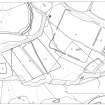Inchtuthil, The Redoubt
Enclosure (Roman)
Site Name Inchtuthil, The Redoubt
Classification Enclosure (Roman)
Alternative Name(s) Stores Compound; Inchtuthil Plateau
Canmore ID 79570
Site Number NO13NW 5.08
NGR NO 1290 3956
Datum OSGB36 - NGR
Permalink http://canmore.org.uk/site/79570
- Council Perth And Kinross
- Parish Caputh
- Former Region Tayside
- Former District Perth And Kinross
- Former County Perthshire
Note (9 December 1992)
NO13NW 5.08 1290 3956.
Traditionally known as 'The Redoubt' and planned by Roy, this enclosure is situated near the NE corner of the plateau to the E of the fortress (NO13NW 5.00). Erosion of the escarpment has destroyed all trace of the defensive perimeter on the SE, but excavation (by Richmond and St Joseph) in 1965 demonstrated that there was probably never more than a simple rampart on this side. Elsewhere, the rampart survives to a greatest height of 1.5m and a breadth of at least 6m, and has an external ditch which measures between 2.2 and 4m in width and up to 4.6m deep.
The area enclosed was about 150m by 130m (1.4ha) and there was a single-portal entrance in the NW side, unusually near the W angle, but at about the closest point to the SE gate of the fortress.
No structures were identified in the interior, but the Roman date of the compound is proved beyond doubt by the associated pottery. A direct connection with the fortress may be suggested by the unusual location of the entrance, but whether this belongs to an early stage in the construction-programme, or to the demolition phase, cannot be determined.
Traces of an earlier ditch (of unknown date and purpose) were also discovered in the course of excavation.
Information from RCAHMS (JRS) 9 December 1992.
W Roy 1793; L F Pitts and J K St Joseph 1985.
Watching Brief (7 April 2010)
An archaeological watching brief on topsoil stripping and excavation required for a house extension at The Gardens, Delvine, Spittalfield, located within the defensive outworks of the Roman Fortress of Inchtuthil and covering an area of 96m². Along with modern pottery, three sherds of late medieval/post-medieval pottery and three sherds of what were considered to be Roman pottery were recovered from garden deposits. Cuts in the subsoil/natural revealed recent working as part of a garden vegetable plot. A stone floor or surface was found that was tied into the foundation of the house wall and was considered to be a stance for an outside tap. Although some medieval and possibly Roman pottery sherds were found, no discrete features or deposits relating to these periods or any other period, apart from modern, were found.
Alder Archaeology Ltd














